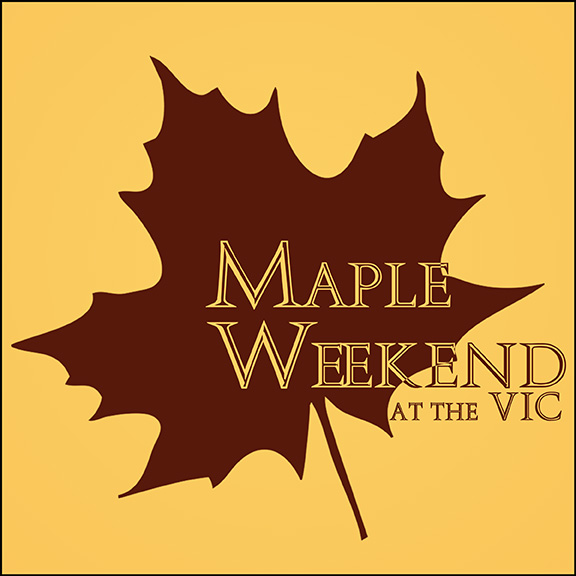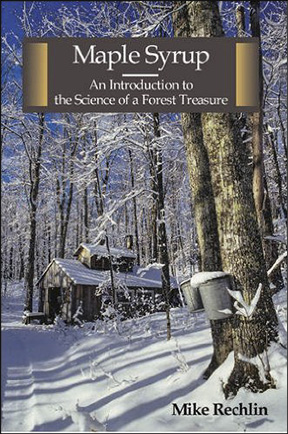Maple Weekend @ Paul Smiths VIC
- Saturday, March 19, 2016, 9:00 AM - 3:00 PM
- Sunday, March 20, 2016, 12:00 PM - 3:00 PM
- Saturday, April 2, 2016, 9:00 AM - 3:00 PM
- Sunday, April 3, 2016, 12:00 PM - 3:00 PM

Sugar maples (Acer saccharum) are deciduous trees that mature in 30-40 years, generally growing to between 70 and 90 feet tall, but able to achieve heights in excess of 100 feet under optimum conditions. They are common throughout much of the northeastern United States and in several eastern Canadian provinces.
It’s no wonder that the sugar maple is the official state tree of New York (designated as such in 1956), Vermont, Wisconsin, and West Virginia. Sugar maples are stunning in forests, especially in the fall, when the leaves turn brilliant shades of crimson, gold, and orange, appreciably contributing to spectacular fall landscapes. They can be remarkably stately shade trees as well; forming 60- to 80-foot-wide crowns, when grown in the open.
The aforementioned states are all large producers of maple syrup, too. Canada, however, (Quebec in particular) produces most of the maple syrup made in North America. The sugar maple is the national tree of Canada and the sugar maple leaf is the Canadian emblem. The national flag of Canada features the image of an 11-point red maple leaf on a white background, bordered by a red field on either side. The flag made its official appearance on February 15, 1965; a date now celebrated as National Flag of Canada Day.
The sugar maple also has noteworthy importance as a timber species; often yielding extremely high-grade, close-grained, hardwood lumber, which is in great demand for flooring, and in making fine furniture. And it’s favored as a premium-quality firewood species, too.
A stand of sugar maple trees being used for making maple syrup or maple sugar is commonly referred to as a sugarbush, and can consist of a few yard trees being tapped by a homeowner or several thousand trees that are being used for large-scale commercial production.
Collecting the sap that brings the sugar maples out of the dormancy of winter is called tapping. Sugar maples generally reach tapping size when they are 40 to 45 years old and, when properly tapped, well cared for trees will continue providing sap for up to 100 years. Sometimes longer.
The tapping process involves drilling a hole about 1 1/2 to 2 inches deep into the trunk of a tree at a slight upward angle, and carefully driving a spout, or tap, into the hole. When conditions are right, sap will flow out of the tap hole. A single tap will generally yield between 10 and 20 gallons of sap per season, but the sap sugar content will vary from tree to tree and from season to season. The sap contains the sugars that fuel the tree's growth and maintenance needs. When enough sap is collected, the water in the accumulated sap can be boiled off. What remains is concentrated sap; or maple syrup. It takes about 40 gallons of sugar maple sap to produce just one gallon of pure maple syrup.
Several other species of maple can be tapped including Norway maples, red maples, silver maples; even box elder (which is sometimes referred to as California maple). A Norway, red, or silver maple tree in excellent health will often produce higher sap sugar concentrations than a sugar maple in poor health.
The Paul Smith’s College VIC is collaborating with the Cornell maple program team to expand maple syrup and sugaring program opportunities in the region. One of the goals is to provide maple syrup production education opportunities for the general public.
Are you ready to learn about maple syrup production and maybe even try tapping a few maple trees? Then join me, along with Paul Smiths College Visitor Interpretive Center (VIC) Facility Manager, Brian MacDonnell, and sugarmakers from the College and the VIC for these upcoming enjoyable and informational events.
Maple Weekend Events at the VIC
‘Sap to Syrup’ Maple Workshop
Date: Saturday, March 19
Time:
9:00 AM to noon
Cost: $20
Information and Registration (Preregistration required): contactBrian McDonnell; bmcdonnell@paulsmiths.edu
Dates: Saturday, March 19 and / or Sunday, March 20
Student-led tours of the VIC Sugarbush
Time: Noon to 2:00 PM
Cost: Free
Maple syrup making demonstrations
Time: Ongoing
Cost: Free
Culinary Uses of Maple Sap
Time: ongoing
Cost: Free
 On Sunday, 20 March, former Paul Smith's College Professor Mike Rechlin will be at the VIC sugar house from noon to 2:00 PM to talk about his new book – Maple Syrup: An Introduction to the Science of a Forest Treasure. The book takes the reader through the what, where, when, and why of maple sap and its conversion to maple syrup, that all-so-appreciated product of the North American deciduous forest.
On Sunday, 20 March, former Paul Smith's College Professor Mike Rechlin will be at the VIC sugar house from noon to 2:00 PM to talk about his new book – Maple Syrup: An Introduction to the Science of a Forest Treasure. The book takes the reader through the what, where, when, and why of maple sap and its conversion to maple syrup, that all-so-appreciated product of the North American deciduous forest.
The goal of Maple Weekend is to provide an opportunity to teach the public about the production of maple syrup and other related products and to share the taste of real mouth-watering maple syrup with visitors. This event is designed to showcase the VIC's maple sugaring operation. The VIC is also holding another maple weekend on 2 & 3 April 2016. For more information, contact: Brian McDonnell,bmcdonnell@paulsmiths.edu
|
Fee
Mostly Free, see schedule for more details
Learn More
http://www.adirondackvic.org/Maple-Weekend-2016.html
Location
Paul Smith's College VIC
8023 State Route 30
Paul Smiths, New York 12970
Last updated February 29, 2016

